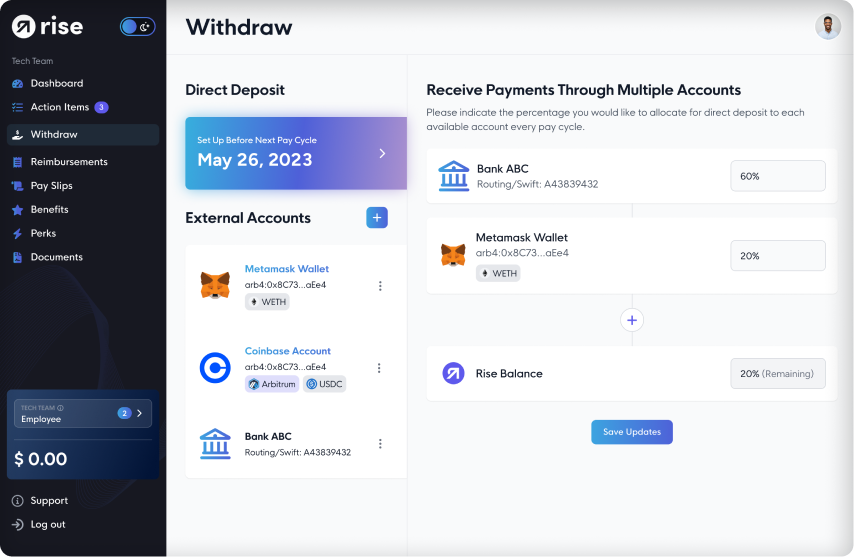
What defines an independent contractor, and how does it affect your work and finances in today’s digital economy?
From legal classifications to tax responsibilities and the intriguing new trend of getting paid in cryptocurrency, this article offers a no-nonsense guide to being or employing independent contractors.
Get ready to gain valuable insights into the independent contractor landscape, including practical tips to navigate these professional waters seamlessly.
Key Takeaways
-
The IRS and FLSA categorize independent contractors based on the degree of control exerted on the worker, focusing on the behavioral and economic aspects of the working relationship to ensure correct classification and prevent misclassification.
-
Cryptocurrency payments to independent contractors are becoming popular due to benefits such as reduced transaction fees and faster processing, but they come with challenges like volatility and regulatory uncertainty.
-
Misclassification of workers can have severe legal and financial consequences for employers; identifying red flags and implementing corrective measures are crucial for compliance and avoiding liabilities.
Defining the Independent Contractor

The term ‘independent contractor’ conjures images of autonomy and freedom—attributes central to the nature of these self-reliant professionals.
Navigating through their work life as self employed individuals, with self-employment tax liabilities, wielding their tools of the trade, and issuing invoices for services rendered, independent contractors are the epitome of self-employment.
Yet, what truly anchors their independent status is not merely the tools they wield or the invoices they issue, but the degree of control they retain—or relinquish—in their professional engagements.
The relationship between an independent contractor and their client or potential employer can be likened to walking a tightrope.
This comparison emphasizes the delicate equilibrium of control: clients should only dictate the work’s end result, while the contractors should have the freedom to choose their work methods and procedures.
It is this nuanced balancing act that determines their independent contractor status and defines the independent contractor agreement.
The Essence of Control in Determining Independent Contractor Status
The IRS casts a discerning eye on the nature of control within the independent contractor relationship. When the question arises whether a worker is an employee or an independent, the answer often lies in the degree of behavioral control exerted over the worker.
The IRS’s definition of an employee stretches to include remote workers if the employer holds the reins on what will be done and how it will be accomplished.
Such a level of control could transform an independent contractor into what the IRS considers an employee, even if their desk isn’t physically anchored within the employer’s business premises.
But control is no single-factor determinant; it’s the entirety of the relationship that comes under scrutiny.
A pervasive presence of company control over when, where, and how the work is performed may point to a misclassification, signaling that the worker is economically dependent on the employer and not truly in command of an independent business.
The right to direct and control, therefore, becomes a focal point in determining the employment status and ensuring that workers are not independent contractors in name only.

Autonomy Over Work: The Key Indicator
Autonomy is the lifeblood of the independent contractor status.
For those who ply their trade in the gig economy, be they graphic designers or freelance writers – autonomy over work tasks is not merely a perk; it is the foundation of their professional existence.
This autonomy is often manifested in the ability to juggle multiple clients, offering services to a diverse roster that can span the globe, a freedom that is heavily tied to their classification as independent contractors.
However, not all that glitters is gold. A worker might find themselves misclassified if they find their wings clipped, unable to soar with other clients or subject to restrictions that confine their work to a single employer.
Such constraints can tarnish the sheen of independence and indicate that the worker is an employee in disguise.
The autonomy over work tasks, therefore, stands as a key determinant and a beacon for those navigating the gig economy waters, ensuring that the worker is an independent in more than just name.
Navigating the Legal Landscape: FLSA and IRS Guidelines
The legal landscape surrounding the classification of workers is a complex one, marked by guidelines from institutions like the Fair Labor Standards Act (FLSA) and the Internal Revenue Service (IRS). These guidelines serve as the compass for navigating the murky waters of the employer-employee relationship.
The FLSA’s ‘economic reality test’ focuses on the degree to which a worker is economically dependent on the business they serve, which in turn illuminates the path to their true classification as either an employee or an independent contractor.
However, classification isn’t solely based on surface-level factors like job titles or work location; the FLSA focuses its attention on the working relationship’s economic realities.
Employers must adhere to these guidelines to ensure accurate classification according to the FLSA’s criteria.
They should also seek legal expertise for compliance verification, a complex yet vital task.
Fair Labor Standards Act: Minimum Wage and Overtime Concerns
Under the watchful eye of the FLSA, the distinction between an independent contractor and an employee is a critical one, with far-reaching implications for minimum wage and overtime pay.
The Act mandates a federal minimum wage and overtime pay at a time-and-a-half rate for hours exceeding the 40-hour workweek mark, but these protections are reserved for those correctly classified as employees and not independent contractors.

A verbal agreement on the independent contractor status between employers and workers isn’t sufficient. The actual work relationship must align with the FLSA’s criteria to prevent misclassification issues.
Should an employer willfully misclassify an employee as an independent contractor, they may find themselves on the hook for up to three years of back overtime payments, a risk that underscores the gravity of proper classification.
Internal Revenue Service: Tax Implications
The IRS draws a distinct line in the sand when it comes to the tax implications of worker classification.
Independent contractors, unlike employees, bear the brunt of self-employment tax and receive their income without withholdings for social security tax, Medicare taxes, or income tax.
Conversely, for employees, these taxes, including income tax withholding, are deducted at the source, along with unemployment tax contributions.
For employers who misclassify workers, the consequences can be substantial. They might be held accountable for all the unwithheld taxes, plus interest and penalties, a sobering reality that underscores the need to determine employment status for careful classification.
To aid in this endeavor, either party can request an IRS determination on the worker’s status using Form SS-8, although patience is a virtue, as the determination process can take upwards of six months.
The Growth of Cryptocurrency Payments to Contractors
The digital age has ushered in a seismic shift in how companies engage with independent contractors, with cryptocurrency payments becoming an increasingly popular method in the gig economy.
Thanks to platforms like Rise, businesses are finding new ways to compensate freelancers for their specialized skills, transcending traditional boundaries and embracing the fluidity of digital currency.

Cryptocurrency presents a fresh, innovative alternative to traditional payment methods.
As the gig economy continues to expand, so too does the appeal of cryptocurrency, offering a glimpse into a future where transactions are not only borderless but also swift and secure, thanks to the transformative power of blockchain technology.
Advantages of Crypto Compensation
The allure of cryptocurrency compensation lies in its numerous benefits for independent contractors. Some of these benefits include:
-
Faster payment processing, circumventing the delays and fees associated with traditional banking systems
-
Reduced transaction fees
-
Anonymity, as freelancers do not have to disclose sensitive personal information
These benefits are a testament to the decentralized nature of digital currencies and the advantages of blockchain technology.
Moreover, cryptocurrency payments offer contractors the following benefits:
-
Freedom to work from anywhere in the world
-
Receiving compensation without the need for currency exchange
-
Eliminating the risk of fraudulent transactions
This level of independence and global accessibility is not just a convenience; it’s a game-changer for the modern workforce.
Challenges and Risks with Cryptocurrency Transactions
Despite its benefits, cryptocurrency payments come with challenges and risks.
The volatile nature of digital currencies can lead to dramatic value fluctuations, threatening the financial stability of gig workers whose earnings could dwindle overnight.
Security is another concern, with the potential for wallet or exchange hacking leading to the loss of funds—a reminder that the digital realm is fraught with its own unique perils.
The regulatory landscape for cryptocurrency is also fraught with uncertainty, with legal implications that could impact the working relationship between companies and contractors.
As the gig economy matures, so must the infrastructure that supports it, ensuring that workers and employers alike can navigate the crypto waters with confidence and clarity.
Rise to the Occasion: How Rise Facilitates Contractor Payments
To address the unique challenges of global contractor payments, Rise offers a comprehensive payroll system specifically designed to handle the complexities of international hybrid payroll.
With a focus on efficiency and compliance, Rise simplifies the payment process, supporting both fiat and cryptocurrency transactions. The platform’s features include:
-
A one-click mass payout feature that exemplifies the ease with which payments can be made to teams anywhere in the world
-
Support for multiple currencies and payment methods
-
Compliance with international regulations and tax requirements
-
Robust security measures to protect sensitive financial information
Rise caters to the fluid nature of the modern workforce, providing a seamless and reliable solution for global contractor payments.

Rise’s value proposition extends beyond its payment capabilities. The platform only charges $2.5 on Layer 1s and FREE on Layer 2s.
By addressing the intricacies of onboarding, tax regulation compliance, and currency conversion, Rise stands out as a facilitator of seamless contractor payments.
Streamlining Onboarding and Compliance
Rise’s automated onboarding process streamlines the entry of new contractors into a company’s ecosystem.
By offering efficient KYC checks and simplifying the generation of legal and tax documents, Rise ensures a smooth transition for contractors from across the globe.
The platform’s commitment to compliance is evident in its robust identity verification services, which manage global compliance issues across 190 countries while adhering to KYC/AML regulations.
Rise’s comprehensive range of features includes:
-
Ability to handle tax forms such as 1099 and W9/W8BEN
-
One-stop solution for contractor onboarding and payment processing
-
1-click mass payouts for prompt and accurate compensation
-
Streamlining the payment process
These features further solidify Rise’s role as a one-stop solution for contractor onboarding and payment processing.
Multi-Currency Convenience: Fiat and Crypto Solutions
The multi-currency support of Rise is a cornerstone of its convenience, offering businesses the flexibility to pay contractors in over 150 countries.
Whether teams prefer to be paid in fiat or cryptocurrency, Rise supports payroll in both, demonstrating its versatility and responsiveness to the needs of a diverse workforce.
Rise offers the following features:
-
Allows teams to receive payments in their chosen currency
-
Facilitates the exchange of cryptocurrencies, including stablecoins, into a variety of other digital currencies
-
Provides the option to be paid in local or preferred fiat currency
These features highlight Rise’s commitment to accommodating a multitude of payment preferences.

Smart Strategies for Managing Independent Contractor Agreements
Managing independent contractor agreements effectively is vital for establishing a transparent and compliant working relationship.
These agreements should:
-
Articulate that the relationship is that of an independent contractor, not an employee, emphasizing the contractor’s autonomy and the specialized skills they bring to the table.
-
Explicitly state that contractors are responsible for adhering to laws and securing their own insurance.
-
Serve as a bulwark against potential legal challenges.
Additionally, such agreements can include provisions for indemnification and remedies, serving to deter contractors from pursuing employee status claims.
The inclusion of clauses that allow or restrict the delegation of contractor tasks also plays a pivotal role in mitigating the risk of misclassifying subcontractors as employees.
The choice of governing law is another strategic consideration, with the potential for certain court decisions to override these choices based on factors such as service locations or party citizenship.
Crafting Clear Contracts
For confidently navigating the complexities of contractor agreements, it’s essential to create clear and comprehensive contracts.
Such contracts should include:
-
Unequivocally stating the legal right of independent contractors to their work, unless otherwise assigned to the employer—a consideration rooted in the Copyright Act of 1976.
-
Incorporating cryptocurrency payments into these agreements with precision.
-
Providing detailed written contracts that provide a layer of security for both parties, ensuring that terms are understood and agreed upon.
Cryptocurrency’s flexibility can be harnessed within contract terms, linking payments to project milestones and thereby aligning compensation with progress as this can prevent delays and foster a mutual sense of achievement.
Additionally, contracts should outline clear conditions for termination and reference separate statements of work, enabling contractors to accept or reject projects with clarity and confidence.
Maintaining Records and Upholding Responsibilities
The saying “the devil is in the details” is particularly relevant when it comes to maintaining records and fulfilling responsibilities within the contractor-employer relationship.
Accurate record-keeping is not just a bureaucratic necessity; it is a cornerstone of transparency that tracks the progress and intricacies of work carried out by independent contractors.
For contractors, diligent documentation of income and business expenses is not just about financial responsibility; it also ensures compliance with tax obligations, safeguarding their independent status.
On the flip side, employers are tasked with providing accurate tax forms, such as the 1099-MISC, and honoring contract terms like payment rates and project durations, all crucial aspects of an employer’s business.
When both contractors and employers hold up their end of the bargain, an employer employee relationship exists that is marked by trust and minimal disputes—a win-win scenario.
The Impact of Misclassification: Risks and Remedies
Misclassifying a worker as an independent contractor can lead to severe consequences, from employers being liable for employment taxes to facing substantial penalties and fines.
It is the employer who shoulders the burden of proof in demonstrating the correct classification of a worker; failure to do so can lead to significant legal exposure, including damages and penalties.
For workers, misclassification means losing access to critical statutory benefits such as paid sick leave, workers’ compensation, and unemployment benefits—a stark reminder of what’s at stake.
Moreover, wage theft looms as a potential risk of misclassification, where workers may not receive the proper wages and benefits they are legally entitled to, including unemployment insurance.
To combat this, misclassified workers can utilize Form 8919 to report their share of uncollected Social Security and Medicare taxes, a corrective measure that also serves as a wake-up call for employers to scrutinize their classification practices and pay employment taxes accordingly.
Identifying Misclassification Red Flags
Identifying red flags for worker misclassification is similar to catching early warning signs in a patient—it can prevent a crisis from fully developing.
Some common red flags to look out for include:
-
The provision of work equipment, such as computers and phones, to those classified as independent contractors
-
Carrying out tasks identical to employees
-
A working relationship that lacks contracted diversity
-
Resembling employee permanence
-
Not involving invoice submissions for payment
These signs may indicate a misclassified worker status.
Engaging workers in a manner akin to employees, such as for extended durations of similar work or re-engaging former employees as consultants for identical duties, could be misclassification red flags.
These scenarios underscore the importance of being vigilant and proactive in maintaining the integrity of the independent contractor status and avoiding the creation of an unintended employment relationship.
Corrective Measures and Compliance Strategies
Businesses must respond quickly and decisively when confronted with potential misclassification. The first step involves a thorough review of existing contracts and work arrangements to identify any discrepancies in classification.
Should misclassifications be uncovered, organizations are tasked with reevaluating the working relationship against federal and state criteria, paying close attention to the degree of control over work and the independence of the worker in business decisions.
Once classifications have been corrected, it’s crucial to implement compliance strategies to prevent recurrence.
This may include:
-
Defining work agreements more clearly
-
Updating agreements in line with legal developments
-
Regularly reviewing these agreements
-
Consulting legal experts when necessary
These steps will help businesses stay ahead of the curve and maintain compliance in an ever-evolving regulatory landscape.
Summary
The journey we’ve embarked upon has illuminated the importance of understanding the nature of independent contractors, navigating the legal complexities, and embracing innovative payment solutions like Rise.
We’ve also delved into the challenges and risks that accompany cryptocurrency transactions, highlighting the need for smart strategies in managing contractor agreements and the perils of misclassification.
In this brave new world of work, it is essential for businesses and contractors alike to remain vigilant, informed, and adaptable.
By crafting clear contracts, maintaining accurate records, and ensuring compliance with regulatory standards, we can harness the potential of cryptocurrency to create a more agile, efficient, and rewarding working environment.
Let this be an invitation to rise to the occasion, embracing the opportunities and navigating the challenges with confidence and foresight.
Frequently Asked Questions
What is Rise?
Rise is a comprehensive payroll and compliance solution designed to streamline payments and onboarding for companies hiring globally. It aims to simplify the process for businesses operating across different locations.
Can Rise process payroll in both fiat and cryptocurrency?
Yes, Rise can process payroll in both fiat and cryptocurrency, offering businesses the flexibility to accommodate their contractors’ currency preferences.
How does Rise ensure legal compliance?
Rise ensures legal compliance by offering robust identity verification services and managing global compliance issues while adhering to KYC/AML regulations. This helps the company to maintain legal compliance.
What are the advantages of using cryptocurrency for contractor payments?
Using cryptocurrency for contractor payments provides advantages such as reduced transaction fees, faster processing, and increased anonymity, making it an appealing option for both contractors and businesses.
What are the challenges associated with cryptocurrency transactions for contractors?
Contractors face challenges with cryptocurrency transactions including volatility, security risks, and regulatory uncertainty, impacting financial stability and legal compliance. It is important to carefully consider these factors before engaging in cryptocurrency transactions.
Image source: Shutterstock
. . .
Tags
- SEO Powered Content & PR Distribution. Get Amplified Today.
- PlatoData.Network Vertical Generative Ai. Empower Yourself. Access Here.
- PlatoAiStream. Web3 Intelligence. Knowledge Amplified. Access Here.
- PlatoESG. Carbon, CleanTech, Energy, Environment, Solar, Waste Management. Access Here.
- PlatoHealth. Biotech and Clinical Trials Intelligence. Access Here.
- Source: https://Blockchain.News/news/benefits-of-paying-independent-contractors-in-cryptocurrency-challenges-and-solutions
- :has
- :is
- :not
- :where
- $UP
- 1
- 150
- a
- ability
- About
- Accept
- access
- accessibility
- accommodate
- accommodating
- accompany
- accomplished
- According
- accordingly
- accountable
- accurate
- achievement
- across
- Act
- actual
- adaptable
- address
- addressing
- adhere
- adhering
- advantages
- affect
- against
- age
- agile
- agreed
- Agreement
- agreements
- ahead
- Aid
- aims
- akin
- align
- aligning
- alike
- All
- allow
- allure
- along
- also
- alternative
- Although
- an
- anchored
- and
- Anonymity
- Another
- answer
- any
- anywhere
- appeal
- appealing
- ARE
- arises
- article
- AS
- aspects
- assigned
- associated
- At
- attention
- author
- Automated
- autonomy
- avoiding
- back
- balancing
- Banking
- based
- BE
- beacon
- Bear
- becomes
- becoming
- been
- before
- behavioral
- being
- benefits
- between
- Beyond
- blockchain
- blockchain technology
- borderless
- both
- both parties
- boundaries
- brave
- bring
- burden
- bureaucratic
- business
- businesses
- but
- by
- call
- CAN
- capabilities
- careful
- carefully
- carried
- casts
- categorize
- caters
- central
- certain
- challenges
- charges
- choice
- choices
- Choose
- chosen
- circumventing
- citizenship
- claims
- clarity
- classification
- classified
- clear
- client
- clients
- Close
- combat
- come
- comes
- command
- commitment
- Common
- Companies
- company
- Company’s
- comparison
- Compass
- Compensation
- complex
- complexities
- compliance
- compliant
- comprehensive
- computers
- Concern
- conditions
- confidence
- confidently
- Consequences
- Consider
- consideration
- considers
- constraints
- consultants
- continues
- contract
- Contractor
- contractors
- contracts
- contributions
- control
- convenience
- Conversion
- copyright
- cornerstone
- correct
- corrected
- correctly
- could
- countries
- Court
- crafting
- create
- creation
- crisis
- criteria
- critical
- crucial
- crypto
- cryptocurrencies
- cryptocurrency
- Cryptocurrency Payments
- currencies
- Currency
- curve
- damages
- decentralized
- decisions
- Defines
- definition
- Degree
- delays
- delegation
- demonstrating
- dependent
- designed
- designers
- desk
- detailed
- determination
- Determine
- determines
- determining
- developing
- devil
- dictate
- different
- digital
- digital age
- digital currencies
- digital currency
- Digital economy
- direct
- Disclose
- distinct
- distinction
- diverse
- do
- documentation
- documents
- does
- done
- dramatic
- draws
- due
- durations
- Early
- Earnings
- ease
- Economic
- economy
- ecosystem
- effectively
- efficiency
- efficient
- either
- embarked
- embracing
- emphasizes
- emphasizing
- employed
- Employee
- employees
- employers
- employing
- employment
- enabling
- end
- endeavor
- engage
- engagements
- engaging
- ensure
- ensures
- ensuring
- entirety
- entitled
- entry
- Environment
- epitome
- Equilibrium
- equipment
- essence
- essential
- establishing
- Even
- evident
- exceeding
- exchange
- exemplifies
- existence
- existing
- exists
- Expand
- expenses
- expertise
- experts
- Exposure
- extended
- extends
- eye
- Face
- facilitates
- facilitator
- facing
- factors
- Failure
- far-reaching
- faster
- Feature
- Features
- Federal
- Fees
- Fiat
- Figure
- Finances
- financial
- financial responsibility
- financial stability
- Find
- finding
- fines
- First
- flags
- Flexibility
- Flip
- fluctuations
- fluid
- fluidity
- focal
- Focus
- focuses
- focusing
- following
- For
- foresight
- form
- Former
- forms
- Foster
- Foundation
- fraudulent
- fraught
- Free
- Freedom
- freelance
- fresh
- from
- fulfilling
- fully
- further
- future
- Gain
- game-changer
- generation
- getting
- gig economy
- Glimpse
- Global
- Globally
- globe
- Gold
- governing
- Graphic
- gravity
- Growth
- guide
- guidelines
- hacking
- handle
- harness
- harnessed
- Have
- heavily
- Held
- help
- helps
- Highlight
- highlighting
- Hiring
- hold
- holds
- honoring
- HOURS
- How
- HTTPS
- Hybrid
- identical
- identify
- identifying
- Identity
- Identity Verification
- if
- images
- Impact
- impacting
- implement
- implementing
- implications
- importance
- important
- in
- include
- includes
- Including
- inclusion
- Income
- income tax
- increased
- increasingly
- indemnification
- independence
- independent
- indicate
- individuals
- info
- informed
- Infrastructure
- innovative
- insights
- institutions
- insurance
- integrity
- interest
- internal
- Internal Revenue Service
- International
- into
- intricacies
- intriguing
- invitation
- invoice
- invoices
- involves
- involving
- IRS
- issue
- issues
- issuing
- IT
- ITS
- Job
- job titles
- journey
- jpg
- just
- Key
- KYC
- KYC/AML
- labor
- landscape
- Law
- Laws
- layer
- Layer 1s
- Layer 2s
- lead
- leading
- Leave
- Legal
- legal experts
- legally
- Level
- liabilities
- liable
- lies
- Life
- lifeblood
- like
- Line
- linking
- local
- location
- locations
- Look
- looms
- losing
- loss
- made
- maintain
- Maintaining
- Making
- manage
- managing
- mandates
- manner
- mark
- marked
- Mass
- matures
- May..
- means
- measure
- measures
- Medicare
- merely
- method
- methods
- might
- Milestones
- minimal
- minimum
- mitigating
- Modern
- months
- more
- multiple
- multitude
- must
- mutual
- name
- Nature
- Navigate
- navigating
- necessity
- Need
- needs
- New
- news
- no
- nuanced
- numerous
- numerous benefits
- obligations
- occasion
- of
- offer
- offering
- Offers
- often
- on
- Onboarding
- ONE
- only
- operating
- opportunities
- Option
- or
- organizations
- Other
- otherwise
- out
- outline
- over
- overnight
- override
- overtime
- own
- paid
- particularly
- parties
- party
- path
- Patience
- Pay
- paying
- payment
- payment methods
- payment processing
- payments
- Payroll
- penalties
- performed
- perk
- personal
- phones
- Physically
- pivotal
- platform
- Platforms
- plato
- Plato Data Intelligence
- PlatoData
- plays
- plus
- Point
- Popular
- potential
- power
- Practical
- practices
- Precision
- prefer
- preferences
- preferred
- presence
- presentation
- presents
- prevent
- Proactive
- procedures
- process
- processing
- professional
- professionals
- Progress
- project
- projects
- proof
- proper
- proposition
- protect
- provide
- provides
- providing
- provision
- question
- quickly
- range
- Rate
- Rates
- ready
- realities
- Reality
- realm
- receive
- record-keeping
- records
- recurrence
- Red
- Red Flags
- Reduced
- reference
- Regulation
- regulations
- regulatory
- regulatory landscape
- reins
- relationship
- relevant
- reliable
- remain
- reminder
- remote
- remote workers
- rendered
- report
- request
- reserved
- Respond
- responsibilities
- responsibility
- responsible
- restrict
- restrictions
- result
- revenue
- review
- reviewing
- rewarding
- right
- Rise
- Risk
- risks
- robust
- Role
- rooted
- roster
- safeguarding
- SAND
- saying
- scenario
- scenarios
- scrutiny
- seamless
- seamlessly
- secure
- securing
- security
- security risks
- Seek
- seismic
- SELF
- sense
- sensitive
- separate
- serve
- serves
- service
- Services
- serving
- severe
- Share
- shift
- should
- shoulders
- side
- significant
- Signs
- similar
- simplifies
- simplify
- simplifying
- single
- SIX
- Six months
- skills
- smart
- smooth
- So
- soar
- sobering
- Social
- solely
- solution
- Solutions
- some
- Source
- span
- specialized
- specifically
- Stability
- Stablecoins
- stake
- standards
- stands
- stark
- start
- State
- statements
- stating
- Status
- stay
- Step
- Steps
- Strategic
- strategies
- streamline
- streamlines
- subject
- Submissions
- substantial
- such
- sufficient
- support
- Supporting
- Supports
- Surrounding
- SWIFT
- system
- table
- Take
- Task
- tasks
- tax
- Taxes
- teams
- Technology
- term
- terms
- testament
- than
- Thanks
- that
- The
- The Source
- theft
- their
- themselves
- thereby
- therefore
- These
- they
- this
- thorough
- those
- three
- Through
- Tied
- tightrope
- tips
- titles
- to
- today’s
- too
- tools
- tracks
- trade
- traditional
- traditional banking
- transaction
- Transaction Fees
- Transactions
- transcending
- Transform
- transformative
- transition
- Transparency
- transparent
- Trend
- true
- truly
- Trust
- TURN
- unable
- Uncertainty
- uncovered
- under
- underscore
- underscores
- understanding
- understood
- unemployment
- unique
- unless
- unlike
- upholding
- upon
- upwards
- ushered
- using
- utilize
- Valuable
- value
- variety
- Verification
- versatility
- vital
- volatile
- Volatility
- wage
- wages
- walking
- Wallet
- warning
- Waters
- ways
- we
- What
- when
- whether
- which
- while
- WHO
- whose
- wielding
- will
- Win-Win
- with
- withholding
- within
- without
- Work
- worker
- workers
- Workforce
- working
- world
- writers
- written
- years
- yet
- Your
- zephyrnet













